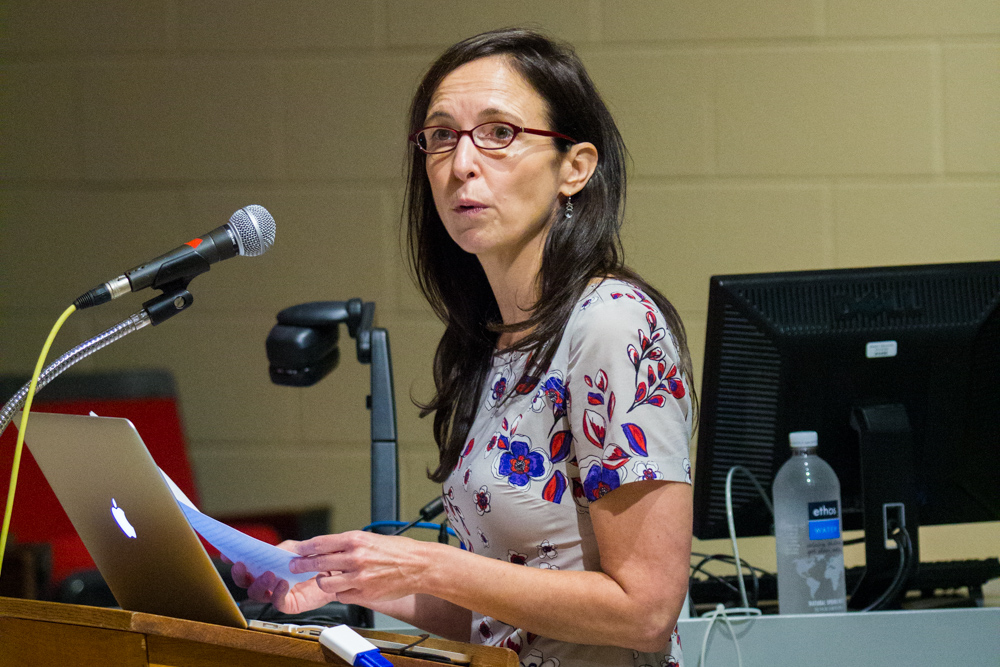Yanna Lambrinidou wants to teach today’s engineers-in-training how to listen to their clients and extended communities. To that end, the professor in Virginia Tech’s Department of Science and Technology has co-developed and co-taught an “Engineering Ethics and the Public” course. She is also principal investigator, with fellow professor Marc Edwards, of a National Science Foundation grant titled “Bridging the Gap Between Engineers and Society: Learning to Listen.”
Lambrinidou has a vested interest in bridging that gap, specifically between water quality engineers and residents who rely on public drinking water. In 2007, she became a lead-in-water activist: first for her hometown of Washington D.C., and then in the Flint, Michigan, crisis.
On Sept. 28, she visited Eastern Mennonite University to explain her activist work; the corruption which allowed the D.C. crisis to develop and fester; and her connection to Flint, which began in 2014. She’s one of a team of Tech scientists volunteering time, expertise, and resources “to help resolve scientific uncertainties associated with drinking water issues being reported in the City of Flint,” according to her team’s website.
Lambrinidou says she hopes her Suter Science Seminar, titled “Flint’s Drinking Water Crisis and the Urgency to Re-imagine Engineers’ Relationship with the Public,” helped foster in the audience “a healthy questioning mindset.”
History of lead pipes
Lambrinidou took audience members back to the early 20th century – when the lead industry made claims of lead’s impressive sanitation effects, running such an effective campaign that lead became the most common material used for water service lines across the country.
By the ’80s, the Environmental Protection Agency (EPA) had instituted its first ban on the use of lead service lines, due to developmental impairments identified in over 250,000 children per year due to lead poisoning. With lead particles rusting or breaking off into water sporadically, Lambrinidou describes drinking tap water as “playing Russian roulette.”
However, the responsibility of remediation fell into the hands of both water utilities and consumers – as different sections of pipe are owned by each party in residential areas. Lambrinidou pointed out that few consumers, to this day – including those listening to her talk – are aware of their partial responsibility to keep lead out of their drinking water.
In Washington D.C.

In 2001, the District of Columbia Water and Sewer Authority (WASA) discovered that, when they switched from chlorine to chloramine to treat drinking water, the water began leaching lead from their service lines at rates well in excess of EPA standards requiring immediate remediation. However, “utility scientists and engineers decided to hide five samples,” explains Lambrinidou, referencing the first incriminating samples taken.
The WASA chief engineer mistakenly thought“crisis averted.” Incidences of elevated blood lead levels in children increased by 9.6 times in 2001, according to information from one area hospital, which also reportedspikes in infant deaths and miscarriages.
A WASA technician, Jerome Krough, began calling consumers individually to warn them. He was fired – the second piece in a years-long cover-up that would spur D.C. residents to begin their own water testing, results communication via chain email, and database creation.
Today, WASA is still fighting families in court over damages resulting from the lead-in-water crisis, says Lambrinidou. She blames the longevity of the issue, in part, on “an institutional disregard for community voices.”
In Flint, Michigan
Enter Flint, Michigan, Lambrinidou’s second case study in communication and perceptions of authority.
Flint is a town with 42 percent of its residents living below the poverty line, which switched from using treated Great Lakes water to untreated Flint River water in 2014. Within a month, the EPA began receiving reports of skin rashes and brown, rotten-egg-smelling water. General Motors claimed the water was “too corrosive” for contact with vehicle parts.
The Michigan Department of Environmental Quality (MDEQ), however, claimed the water met EPA standards – before it had even been tested for lead.
Flint parents began seeing stunted growth, hair loss, and stomach pain in their children, and eventually turned to Virginia Tech for help testing their own water. They collected over 250 samples, 30 percent of which exceeded EPA standards requiring immediate remediation.
“Flint has a very serious lead-in-water problem,” the university announced. EPA Regional Regulations Manager Miguel delToral eventually stepped in, urging his superiors to take action.
However, “traditional power structures that assume ‘experts know best’ are the norm,” says Lambrinidou, and MDEQ continued to use misleading testing methods to avoid taking responsibility. Flint eventually reverted to its former water source, but court cases and medical implications from the crisis are ongoing.
Concerning the media attention and remediation that has been achieved, the dominant narrative is that Flint families – the grassroots researchers and organizers who were working to improve the situation months before the EPA stepped in – were “saved” by the experts, says Lambrinidou. “Engineers have a critical role to play helping communities save their own day,” she explains.
‘Holes in the system’
Lambrinidou says there are “holes in our regulatory system that create and perpetuate injustice” – such as layman research being discredited, parents of lead-poisoned children being kept out of remediation forums, and less-educated citizens not knowing how to request helpful documents through the Freedom of Information Act. Engineers tend to value methodical efficiency, “values [which] can stunt the engineer’s ability to bring long-standing systemic change.” Lambrinidou says that positive community change often happens with “slow and messy progress towards people’s empowerment.”
Moving forward, Lambrinidou’s work in this field is “bringing social justice perspectives into federal policy making.” She asks, “What role do technical interventions play” in these multi-layered crises? “What conditions allow communities to save themselves,” rather than relying on outside regulators?
